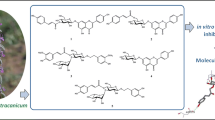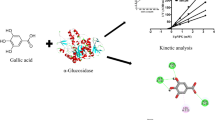Abstract
Fruits of Syzygium jambos (L.) are recognized as a “food”, exhibiting significant antidiabetic activities. However, the α-glucosidase inhibition of the components from Syzygium jambos (L.) have not yet been investigated. In this study, a total of 14 compounds were isolated from Syzygium jambos (L.) Alston, eight of which showed significant inhibitory effects on α-glucosidase, with IC50 values in the range of 0.011–0.665 mM. Notably, compounds 1–3 (IC50: 0.013, 0.011 and 0.030 mM, respectively) exhibited much stronger activity than acarbose (IC50: 2.329 ± 0.109 mM). The enzyme kinetics study indicated that compound 1 was an uncompetitive inhibitor, and compounds 2–8 were mixed-type inhibitors. Moreover, the interactions between compounds and α-glucosidase were investigated by molecular docking, which further revealed that the number of olefin double bonds and 2-COOH of heptadeca-phenols had a notable effect on the α-glucosidase inhibitory activity. This study demonstrated that Syzygium jambos (L.) fruit might serve as a functional food for the prevention of diabetes mellitus.






Similar content being viewed by others
Data Availability
All data generated or analyzed during this study are included in this article and its supplementary information files.
References
Piero MN, Nzaro GM, Njagi JM (2015) Diabetes mellitus-a devastating metabolic disorder. Asian J Biomed Pharm Sci 5:1. https://doi.org/10.15272/ajbps.v4i40.645
Narjis M, Noreen M, Safi SZ, Ilahi NE, Alomar SY, Alkhuriji AF (2021) Cross talk between complete blood count and progression of type II diabetes mellitus. J King Saud Univ-Sci 33:101492. https://doi.org/10.1016/j.jksus.2021.101492
Alarcón-Espósito J, Nina N, Theoduloz C, Burgos-Edwards A, Paillan H, Schmeda-Hirschmann G (2022) Phenolic composition and α-glucosidase inhibition of leaves from Chilean bean landraces. Plant Foods Hum Nutr 77:135–140. https://doi.org/10.1007/s11130-022-00955-6
Usman B, Sharma N, Satija S, Mehta M, Vyas M, Khatik GL, Dua K (2019) Recent developments in alpha-glucosidase inhibitors for management of type-2 diabetes: an update. Curr Pharm Des 25:2510–2525. https://doi.org/10.2174/1381612825666190717104547
Feng J, He FM, Huang YH, Zhou M, Liu XZ, Ye XS, Yang RJ, Tian WJ, Chen HF (2022) Inhibitory effects of phenolic glycosides from Trollius chinensis bunge on α-glucosidase: inhibition kinetics and mechanisms. Food Funct 13:2857. https://doi.org/10.1039/D1FO03347F
Perreault L, Skyler JS, Rosenstock J (2021) Novel therapies with precision mechanisms for type 2 diabetes mellitus. Nat Rev Endocrinol 17:364–377. https://doi.org/10.1038/s41574-021-00489-y
Kim S, Semple SJ, Simpson BS, Deo P (2020) Antioxidant and antiglycation activities of Syzygium paniculatum gaertn and inhibition of digestive enzymes relevant to type 2 diabetes mellitus. Plant Foods Hum Nutr 75:621–627. https://doi.org/10.1007/s11130-020-00858-4
López-Angulo G, Montes-Avila J, Díaz-C Sánchez-Ximello L-, SP, Miranda-Soto V, López-Valenzuela JA, Delgado-Vargas F, (2018) Anthocyanins of Pithecellobium dulce (Roxb.) Benth. fruit associated with high antioxidant and α-glucosidase inhibitory activities. Plant Foods Hum Nutr 73:308–313. https://doi.org/10.1007/s11130-018-0693-y
Sharma R, Kishore N, Hussein A, Lall N (2013) Antibacterial and anti-inflammatory effects of Syzygium jambos L. (Alston) and isolated compounds on acne vulgaris. BMC Complementary Altern Med 13:1–10. https://doi.org/10.1186/1472-6882-13-292
Subbulakshmi K, Satish S, Shabaraya AR (2021) Rose apple fruit: a pharmacological review. World J Pharm Pharm Sci 10:842–849. https://doi.org/10.20959/wjpps20214-18707
Ochieng MA, Ben Bakrim W, Bitchagno GTM, Mahmoud MF, Sobeh M (2022) Syzygium jambos L. Alston: an insight into its phytochemistry, traditional uses, and pharmacological properties. Front Pharmacol 13:22. https://doi.org/10.3389/fphar.2022.786712
Amir Rawa MS, Nurul Azman NA, Mohamad S, Nogawa T, Wahab HA (2022) In vitro and in silico anti-acetylcholinesterase activity from Macaranga tanarius and Syzygium jambos. Molecules 27:2648. https://doi.org/10.3390/molecules27092648
Teixeira CC, Fuchs FD, Blotta RM, Knijnik J, Delgado IC, Netto MS, Gastaldo G (1990) Effect of tea prepared from leaves of Syzygium jambos on glucose tolerance in nondiabetic subjects. Diabetes Care 13:907–908. https://doi.org/10.2337/diacare.13.8.907
Gavillán-Suárez J, Aguilar-Perez A, Rivera-Ortiz N, Rodríguez-Tirado K, Figueroa-Cuilan W, Morales-Santiago L, Martínez-Montemayor MM (2015) Chemical profile and in vivo hypoglycemic effects of Syzygium jambos, Costus speciosus and Tapeinochilos ananassae plant extracts used as diabetes adjuvants in Puerto Rico. BMC Complementary Altern Med 15:1–15. https://doi.org/10.1186/s12906-015-0772-7
Mohamed Yunus SN, Abas F, Jaafar AH, Azizan A, Zolkeflee NKZ, Abd Ghafar SZ (2021) Antioxidant and α-glucosidase inhibitory activities of eight neglected fruit extracts and UHPLC-MS/MS profile of the active extracts. Food Sci Biotechnol 30:195–208. https://doi.org/10.1007/s10068-020-00856-x
Oh J, Hwang IH, Hong CE, Lyu SY, Na M (2013) Inhibition of fatty acid synthase by ginkgolic acids from the leaves of Ginkgo biloba and their cytotoxic activity. J Enzyme Inhib Med Chem 28:565–568. https://doi.org/10.3109/14756366.2012.658786
Coates NJ, Gilpin ML, Gwynn MN, Lewis DE, Milner PH, Spear SR, Tyler JW (1994) SB-202742, a novel β-lactamase inhibitor isolated from Spondias mombin. J Natl Prod 57:654–657. https://doi.org/10.1021/np50107a016
Knödler M, Conrad J, Wenzig EM, Bauer R, Lacorn M, Beifuss U (2008) Schieber A Anti-inflammatory 5-(11′ Z-heptadecenyl)-and 5-(8′ Z, 11′ Z-heptadecadienyl)-resorcinols from mango (Mangifera indica L.) peels. Phytochemistry 69:988–993. https://doi.org/10.1016/j.phytochem.2007.10.013
Hu YK, Wang L, Wang JH, Li MJ, Li F, Yang J, Zhao Y (2021) Resorcinol derivatives with α-glucosidase inhibitory activities from Syzygium samarangense. Natl Prod Res 35:5948–5953. https://doi.org/10.1080/14786419.2020.1805606
Güvenalp Z, Özbek H, Dursunoğlu B, Yuca H, Gözcü S, Çil YM, Kazaz C, Kara K, Demirezer ÖL (2017) α-Amylase and α-glucosidase inhibitory activities of the herbs of Artemisia dracunculus L. and its active constituents. Med Chem Res 26:3209–3215. https://doi.org/10.1007/s00044-017-2014-7
Varsha KK, Devendra L, Shilpa G, Priya S, Pandey A, Nampoothiri KM (2015) 2,4-di-tert-butyl phenol as the antifungal, antioxidant bioactive purified from a newly isolated Lactococcus sp. Int J Food Microbiol 211:44–50. https://doi.org/10.1016/j.ijfoodmicro.2015.06.025
Fischer FC, Gijbels MJM (1987) cis-and trans-neocnidilide, 1H-and 13C-NMR data of some phthalides. Planta Med 53:77–80. https://doi.org/10.1055/s-2006-962626
Seo KH, Lee DY, Nam TG, Kim DO, Lee DG, Kim EK, Kang HC, Song MC, Baek NI (2013) New tocopherol analogue with radical-scavenging activity from the peels of Citrus unshiu Marcovich. J Korean Soc Appl Biol Chem 56:747–750. https://doi.org/10.1007/s13765-013-3230-6
Rasool N, Khan AQ, Ahmad VU, Malik A (1991) A benzoquinone and a coumestan from Psoralea plicata. Phytochemistry 30:2800–2803. https://doi.org/10.1016/0031-9422(91)85151-O
Chaturvedula VSP, Norris A, Miller JS, Ratovoson F, Andriantsiferana R, Rasamison VE, Kingston DGI (2006) Cytotoxic diterpenes from Cassipouream adagascariensis from the Madagascar Rainforest. J Nat Prod 69:287–289. https://doi.org/10.1021/np050376w
Ramaiah PA, Devi PU, Frolow F, Lavie D (1984) 3-Oxo-friedelan-20α-oic acid from Gymnosporia emarginata. Phytochemistry 23:2251–2255. https://doi.org/10.1016/S0031-9422(00)80530-0
Rehman NU, Halim SA, Al-Azri M, Khan M, Khan A, Rafiq K, Al-Rawahi A, Csuk R, Al-Harrasi A (2020) Triterpenic acids as non-competitive α-glucosidase inhibitors from Boswellia elongata with structure-activity relationship: in vitro and in silico studies. Biomolecules 10:751. https://doi.org/10.3390/biom10050751
Hossain U, Das AK, Ghosh S, Sil PC (2020) An overview on the role of bioactive ameliorating diabetic complications. Food Chem Toxicol 145:111738. https://doi.org/10.1016/j.fct.2020.111738
Mocan A, Zengin G, Crişan G, Mollica A (2016) Enzymatic assays and molecular modeling studies of Schisandra chinensis lignans and phenolics from fruit and leaf extracts. J Enzyme Inhib Med Chem 31:200–210. https://doi.org/10.1080/14756366.2016.1222585
Acknowledgements
The authors are thankful to National Natural Science Foundation of China (No. 31900293).
Funding
This work was funded by Department of Science and Technology of Sichuan Province (2022NSFSC0109), Sichuan Science and Technology Program (2022YFS0624), the Open Project of Sichuan Industrial Institute of Antibiotics, Chengdu University (ARRLKF20-04), Sichuan Traditional Chinese Medicine Administration (2023zd008).
Author information
Authors and Affiliations
Contributions
All authors contributed to the study conception and design. YJ: conducted the experiment, wrote the manuscript draft. DZ: Performed α-glycosidase inhibitory activities, data analysis. FFL: Performed HRESIMS data analysis. LH: Contributed to NMR spectra data analysis, read and approve the manuscript. XJF: IR spectrometer data analysis. NH: Performed molecular docking. SWC: Contributed to bioassay experiments. MW: Performed the revise of the manuscript. ZL: Contributed to read and revise the manuscript.
Corresponding authors
Ethics declarations
Competing interests
The authors declare no competing interests.
Human and Animal Participants
This article does not contain any studies with human or animal subjects.
Competing interests
The authors declare no competing interests.
Additional information
Publisher's Note
Springer Nature remains neutral with regard to jurisdictional claims in published maps and institutional affiliations.
Supplementary Information
Below is the link to the electronic supplementary material.
Rights and permissions
Springer Nature or its licensor (e.g. a society or other partner) holds exclusive rights to this article under a publishing agreement with the author(s) or other rightsholder(s); author self-archiving of the accepted manuscript version of this article is solely governed by the terms of such publishing agreement and applicable law.
About this article
Cite this article
Jiang, Y., Liu, F., Zhang, D. et al. Identification of Novel -Glucosidase Inhibitors from Syzygium jambos (L.) Using Spectroscopy and Molecular Docking. Plant Foods Hum Nutr 79, 73–82 (2024). https://doi.org/10.1007/s11130-023-01123-0
Accepted:
Published:
Issue Date:
DOI: https://doi.org/10.1007/s11130-023-01123-0




